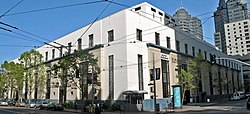
Coit Tower is a 210-foot (64 m) tower in the Telegraph Hill neighborhood of San Francisco, California, overlooking the city and San Francisco Bay. The tower, in the city's Pioneer Park, was built between 1932 and 1933 using Lillie Hitchcock Coit's bequest to beautify the city of San Francisco. It was added to the National Register of Historic Places on January 29, 2008.

Daniel Rhodes was an American artist, known as a ceramic artist, muralist, sculptor, author and educator. During his 25 years (1947–1973) on the faculty at the New York State College of Ceramics at Alfred University, in Alfred, New York, he built an international reputation as a potter, sculptor and authority on studio pottery.
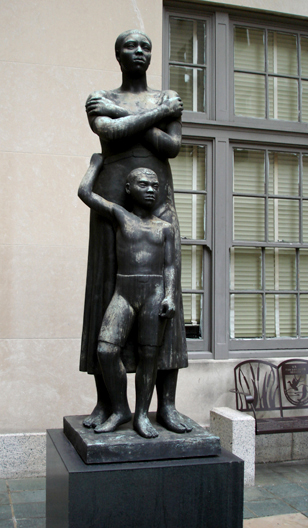
The Public Works of Art Project (PWAP) was a New Deal work-relief program that employed professional artists to create sculptures, paintings, crafts and design for public buildings and parks during the Great Depression in the United States. The program operated from December 8, 1933, to May 20, 1934, administered by Edward Bruce under the United States Treasury Department, with funding from the Federal Emergency Relief Administration.

George Washington High School is a public high school in Richmond District, San Francisco, California. In 2011, Washington High was ranked by Newsweek's Jay Mathews Challenge Index as the 497th best high school in the United States.

Rincon Center is a complex of shops, restaurants, offices, and apartments in the South of Market neighborhood of Downtown San Francisco, California. It includes two buildings, one of which is the former Rincon Annex post office building, completed in 1940. Rincon Center occupies an entire city block near the Embarcadero, bounded by Mission, Howard, Spear, and Steuart Streets.

Anton Refregier was a painter and muralist active in Works Progress Administration Federal Art Project commissions, and in teaching art. He was a Russian immigrant to the United States.

Henry Varnum Poor was an American architect, painter, sculptor, muralist, and potter. He was a grandnephew of the Henry Varnum Poor who was a founder of the predecessor firm to Standard & Poor's.
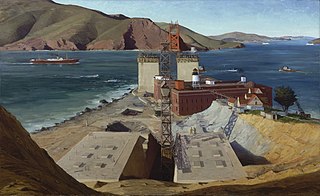
Ray Stanford Strong was an American painter from Corvallis, Oregon. He associated with the New Deal muralists in the San Francisco Bay Area.

Maxine Albro was an American painter, muralist, lithographer, mosaic artist, and sculptor. She was one of America's leading female artists, and one of the few women commissioned under the New Deal's Federal Art Project, which also employed Jackson Pollock, Mark Rothko, and Willem de Kooning.

The San Francisco riot of 1877 was a three-day pogrom waged against Chinese immigrants in San Francisco, California by the city's majority white population from the evening of July 23 through the night of July 25, 1877. The ethnic violence which swept Chinatown resulted in four deaths and the destruction of more than $100,000 worth of property belonging to the city's Chinese immigrant population.

Bernard Baruch Zakheim was a Warsaw-born San Francisco muralist, best known for his work on the Coit Tower murals.

Victor Mikhail Arnautoff was a Russian-American painter and professor of art. He worked in San Francisco and the Bay Area from 1925 to 1963, including two decades as a teacher at Stanford University, and was particularly prolific as a muralist during the 1930s. He became a naturalized U.S. citizen, but returned to the Soviet Union after the death of his wife, continuing his career there before his death.
Pan American Unity is a mural painted by Mexican artist and muralist Diego Rivera for the Art in Action exhibition at Treasure Island's Golden Gate International Exposition (GGIE) in San Francisco, California in 1940. This work was the centerpiece of the Art In Action exhibit, which featured many different artists engaged in creating works during the Exposition while the public watched.
Ray Boynton (1883–1951) also known as Raymond Boynton, was an American artist and arts educator, most famous for his mural work in California during the Great Depression where he earned commissions under the Public Works of Art Project (PWAP) and the Treasury Relief Art Project (TRAP).
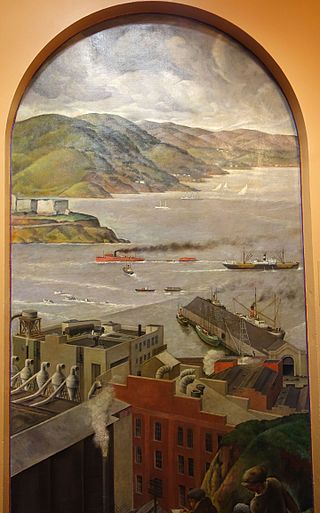
José Moya del Piño (1891–1969) was a Spanish-born American painter, muralist and educator. He associated with the Post-impressionists of Spain and the Depression-era muralists in the San Francisco Bay Area. He taught classes at the San Francisco Art Students League, San Francisco Art Institute and the College of Marin.

Helen Katharine Forbes was a Californian artist and arts educator specializing in etching, murals and painting. She is best known for western landscapes, portrait paintings, and her murals with the Treasury Section of Fine Arts and Work Progress Administration (WPA). Forbes was skilled in painting in oil, watercolor, and egg tempera. She painted landscapes of Mexico, Mono Lake and the Sierras in the 1920s, desert scenes of Death Valley in the 1930s, and portraits and still-lifes.
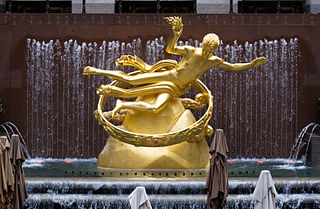
The Art Deco style, which originated in France just before World War I, had an important impact on architecture and design in the United States in the 1920s and 1930s. The most famous examples are the skyscrapers of New York City including the Empire State Building, Chrysler Building, and Rockefeller Center. It combined modern aesthetics, fine craftsmanship and expensive materials, and became the symbol of luxury and modernity. While rarely used in residences, it was frequently used for office buildings, government buildings, train stations, movie theaters, diners and department stores. It also was frequently used in furniture, and in the design of automobiles, ocean liners, and everyday objects such as toasters and radio sets. In the late 1930s, during the Great Depression, it featured prominently in the architecture of the immense public works projects sponsored by the Works Progress Administration and the Public Works Administration, such as the Golden Gate Bridge and Hoover Dam. The style competed throughout the period with the modernist architecture, and came to an abrupt end in 1939 with the beginning of World War II. The style was rediscovered in the 1960s, and many of the original buildings have been restored and are now historical landmarks.
Life of Washington is a mural cycle in San Francisco's George Washington High School painted by Victor Arnautoff in 1936. It depicts George Washington at various real and imagined points in his life. Composed of 13 panels and spanning 1600 square feet, the work was the largest mural by a single artist that the WPA funded. According to the art critic Roberta Smith, the cycle is "among the most honest and possibly the most subversive of the W.P.A. era".

Palo Alto Medical Clinic, also known as the Roth Building was a former medical clinic. The building is located at 300 Homer street, at the corner of Bryant street in Palo Alto, California. It is listed on the National Register of Historic Places listings in Santa Clara County, California since 2010. The building is a good example of Spanish Colonial Revival architecture, and has historical relevance for the Palo Alto community, art history, and medical history.
Boris Deutsch (1892–1978) was a naturalized American painter.


